Potrebujeme váš súhlas na využitie jednotlivých dát, aby sa vám okrem iného mohli ukazovať informácie týkajúce sa vašich záujmov. Súhlas udelíte kliknutím na tlačidlo „OK“.
ASTM E1486M-14
Standard Test Method for Determining Floor Tolerances Using Waviness, Wheel Path and Levelness Criteria (Metric)
Automaticky preložený názov:
Štandardná skúšobná metóda pre stanovenie podlahové Tolerancia pomocou zvlnenie, cesta kolies a rovinnosť Kritériá (metrické)
NORMA vydaná dňa 1.4.2014
Informácie o norme:
Označenie normy: ASTM E1486M-14
Poznámka: NEPLATNÁ
Dátum vydania normy: 1.4.2014
Kód tovaru: NS-41925
Počet strán: 13
Približná hmotnosť: 39 g (0.09 libier)
Krajina: Americká technická norma
Kategória: Technické normy ASTM
Kategórie - podobné normy:
Anotácia textu normy ASTM E1486M-14 :
Keywords:
ICS Number Code 91.060.30 (Ceilings. Floors. Stairs)
Doplňujúce informácie
| Significance and Use | ||
|
5.1 This test method provides statistical and graphical information concerning floor surface profiles. 5.2 Results of this test method are for the purpose of the following: 5.2.1 Establishing compliance of random or fixed-path trafficked floor surfaces with specified tolerances; 5.2.2 Evaluating the effect of different construction methods on the waviness of the resulting floor surface; 5.2.3 Investigating the curling and deflection of concrete floor surfaces; 5.2.4 Establishing, evaluating, and investigating the profile characteristics of other surfaces; and 5.2.5 Establishing, evaluating, and investigating the levelness characteristics of surfaces. 5.3 Application: 5.3.1 Random Traffic—When the traffic patterns across a floor are not fixed, two sets of survey lines approximately equally spaced and at right angles to each other shall be used. The survey lines shall be spaced across the test section to produce lines of approximately equal total length, both parallel to and perpendicular to the longest test section boundary. Limits are specified in 7.2.2 and 7.3.2. 5.3.2 Defined Wheel Path Traffic—For surfaces primarily intended for defined wheel path traffic, only two wheel paths and the initial transverse elevation difference (“side-to-side”) between wheels shall be surveyed. 5.3.3 Time of Measurement—For new concrete floor construction, the elevation measurements shall be made within 72 h of final concrete finishing. For existing structures, measurements shall be taken as appropriate. 5.3.4 Elevation Conformance—Use is restricted to shored, suspended surfaces. 5.3.5 RMS Levelness—Use is unrestricted, except that it is excluded from use with cambered surfaces and unshored, elevated surfaces. |
||
| 1. Scope | ||
|
1.1 This test method covers data collection and analysis procedures to determine surface flatness and levelness by calculating waviness indices for survey lines and surfaces, elevation differences of defined wheel paths, and levelness indices using SI units. 1.1.1 The purpose of this test
method is to provide the user with floor tolerance estimates as
follows:
1.1.1.1 Local survey line waviness and overall surface waviness indices for floors based on deviations from the midpoints of imaginary chords as they are moved along a floor elevation profile survey line. End points of the chords are always in contact with the surface. The imaginary chords cut through any points in the concrete surface higher than the chords. 1.1.1.2 Defined wheel path criteria based on transverse and longitudinal elevation differences, change in elevation difference, and root mean square (RMS) elevation difference. 1.1.1.3 Levelness criteria for surfaces characterized by either of the following methods: the conformance of elevation data to the test section elevation data mean; or by the conformance of the RMS slope of each survey line to a specified slope for each survey line. 1.1.2 The averages used throughout these calculations are the root mean squares, RMS (that is, the quadratic means). This test method gives equal importance to humps and dips, measured up (+) and down (−), respectively, from the imaginary chords. 1.1.3 Appendix X1 is a commentary on this test method. 1.2 The values stated in SI units are to be regarded as standard. No other units of measurement are included in this standard. 1.3 This standard does not purport to address all of the safety concerns, if any, associated with its use. It is the responsibility of the user of this standard to establish appropriate safety and health practices and determine the applicability of regulatory limitations prior to use. |
||
| 2. Referenced Documents | ||
|
Podobné normy:
Historická
1.4.2009
Historická
15.1.2014
Historická
1.10.2010
Historická
1.4.2013
Historická
15.11.2006
Historická
1.5.2008


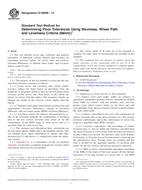
 ASTM E2322-03(2009)..
ASTM E2322-03(2009)..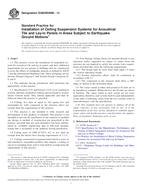 ASTM E580/E580M-14..
ASTM E580/E580M-14.. ASTM E894-88(2010)..
ASTM E894-88(2010)..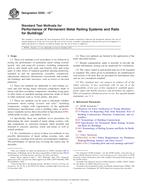 ASTM E935-13e1
ASTM E935-13e1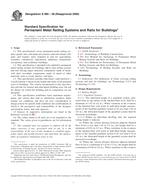 ASTM E985-00(2006)..
ASTM E985-00(2006)..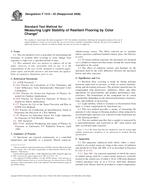 ASTM F1515-03(2008)..
ASTM F1515-03(2008)..
 Cookies
Cookies
